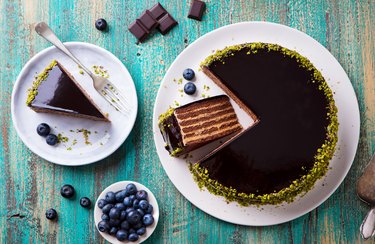
We have all been there. You've started the recipe, but when you go to the refrigerator to get the milk, someone else has gotten to it before you. Do you drop everything and run to the store or is there a viable substitute for milk?
There's no need to panic. As long as you have water and a little butter, you have your replacement for milk in baking your cake.
Video of the Day
Video of the Day
Tip
If you're baking and realize you don't have milk, there's good news. One cup of whole milk can be replaced with one cup of water, plus 1.5 teaspoons of butter.
Milk Vs. Water in Baking
According to the USDA, 88 percent of the volume of milk is actually water. This nutrient-rich food supports you physically through childhood and beyond and is also a common ingredient in many of the foods you eat.
Each ingredient you add to your cake has a specific function. In a basic butter cake, creaming the sugar with the butter before adding either to the batter not only makes your cake sweet but helps add air to the butter and distributes its fat more evenly.
This promotes a finer cell structure to the texture of the cake. Eggs add protein, flavor and color. Milk in a cake hydrates the dry ingredients, dissolves the sugar and helps the baking powder produce carbon dioxide to raise the cake.
Substituting Water for Milk
Milk's most important role in baking a perfect cake is the part it plays in making the batter wet enough for the chemical reactions to take place. In a pinch, if milk is not available, water may be substituted. To replace 1 cup of whole milk in a cake recipe, you can use 1 cup of water and 1 1/2 teaspoons of butter, according to Colorado State University Extension.
Using water and butter as a replacement for milk in baking doesn't significantly impact the nutritional value. One cup of whole milk also provides 7.7 grams of protein and 7.9 grams of total fat, of which 4.6 are saturated — the "worst" kind of fat that can contribute to heart disease, according to Mayo Clinic.
One cup of water mixed with 1 1/2 teaspoons of butter contains no protein and 5.5 grams of total fat, including 3.5 grams of saturated fat, according to the USDA.
While using the ingredients called for in the recipe is always best for the finished product, sometimes this is not possible. Most kitchens carry reasonable substitutions for basic ingredients, but careful consideration should be given to the outcome of your end product.
In this case, substituting water with extra butter for milk should produce a cake with little or no noticeable differences. The taste, weight and texture of the cake should be similar, and there should be no crumbling or dryness if the recipe and baking times are followed.